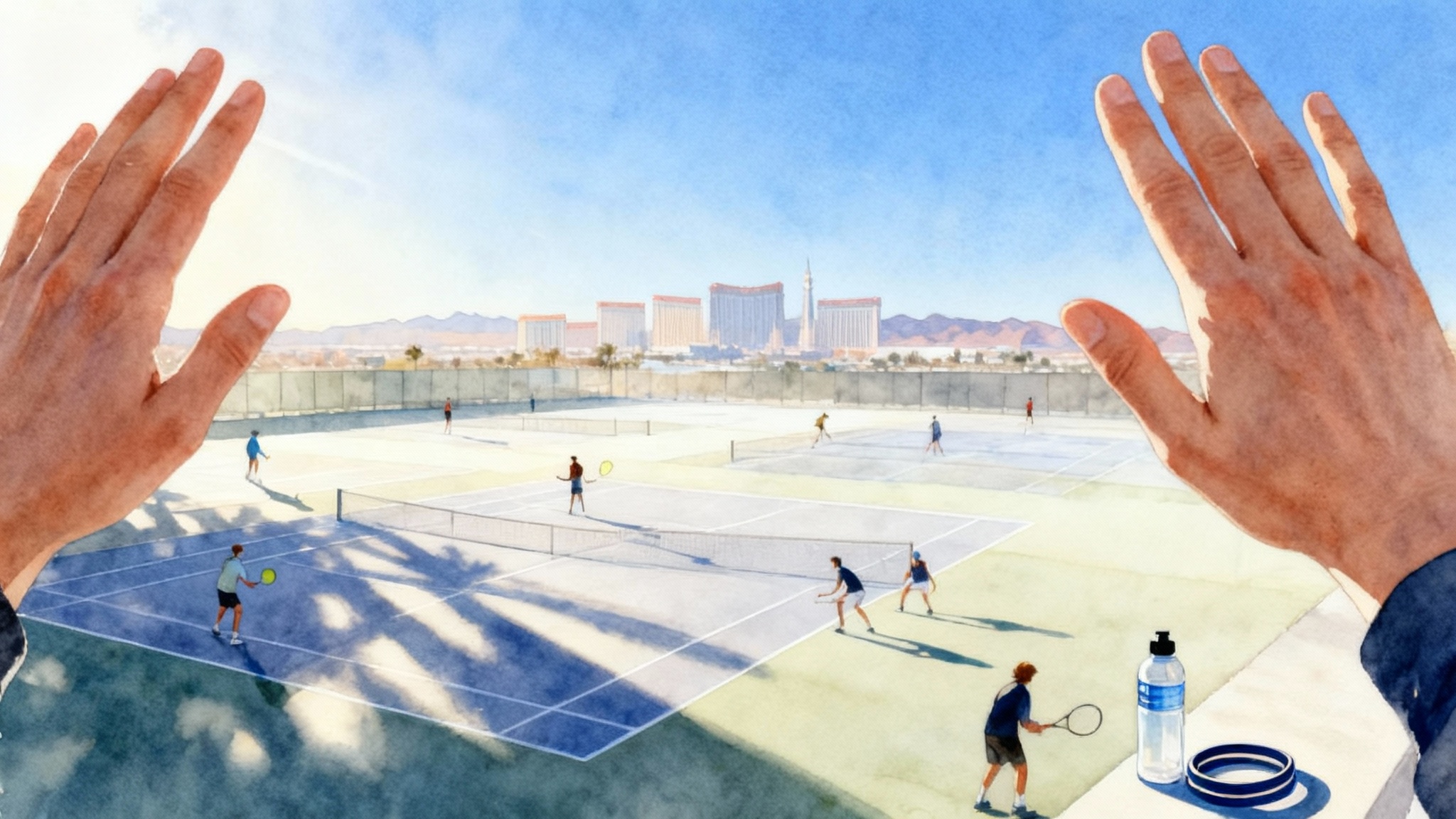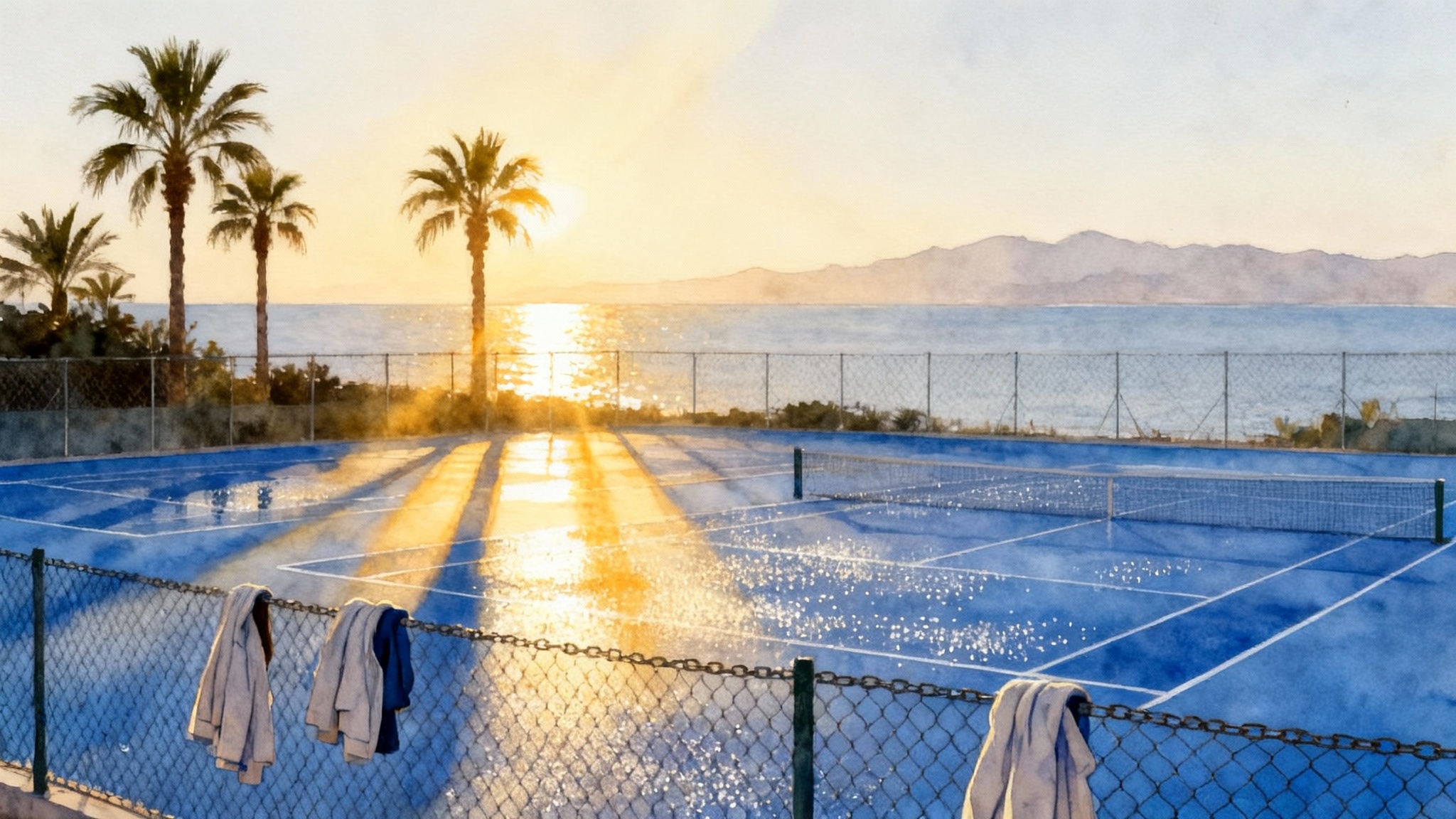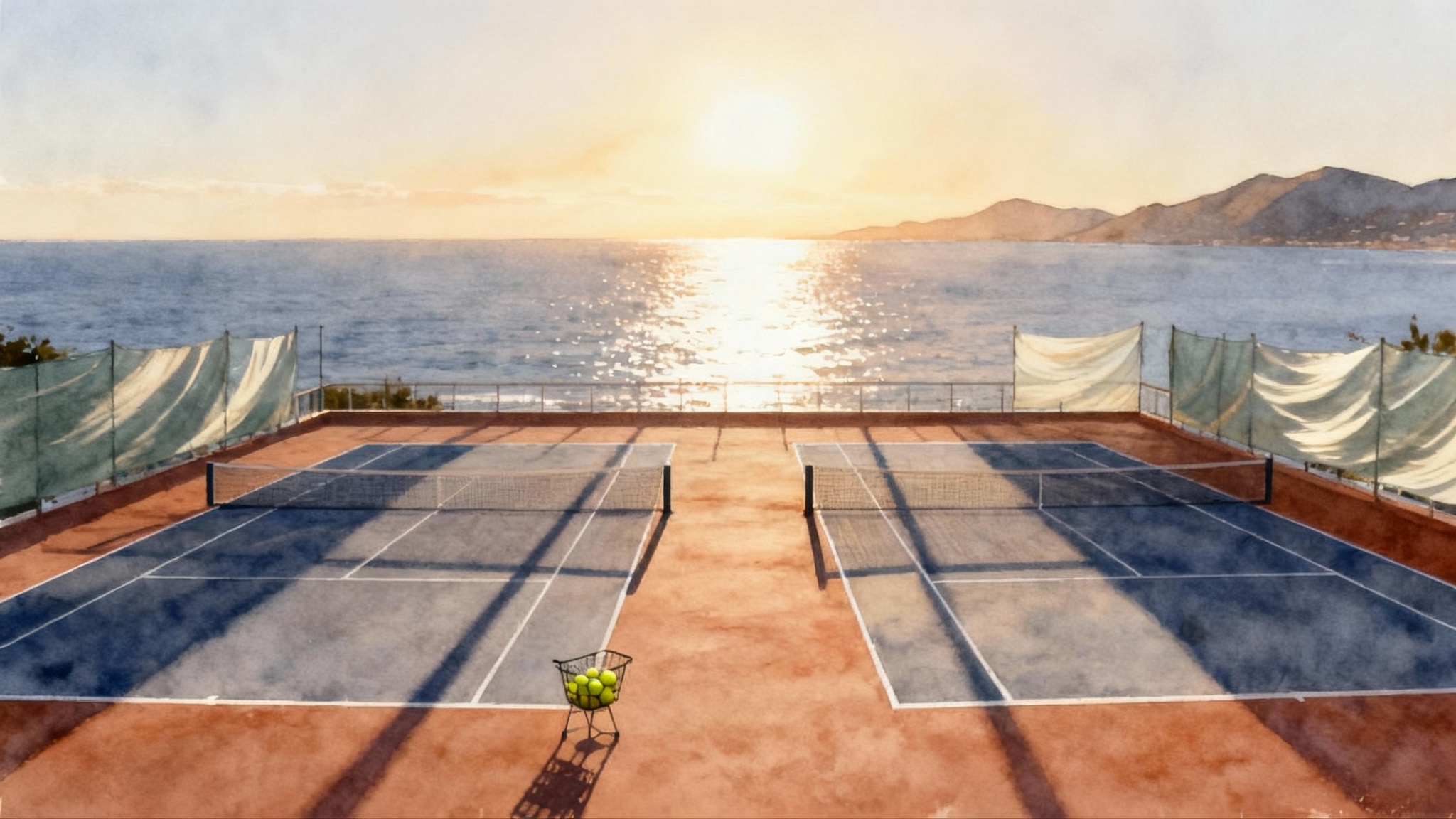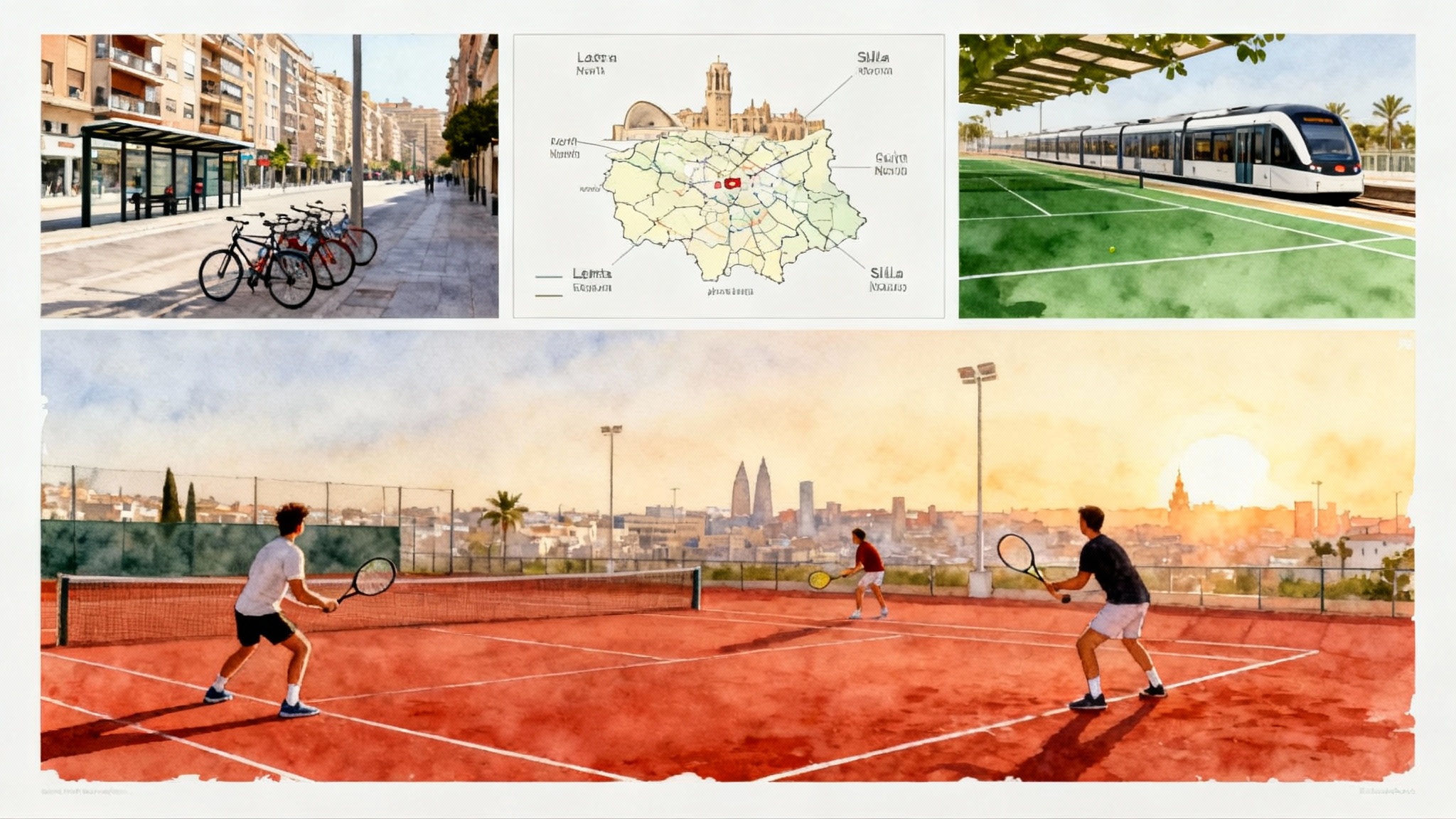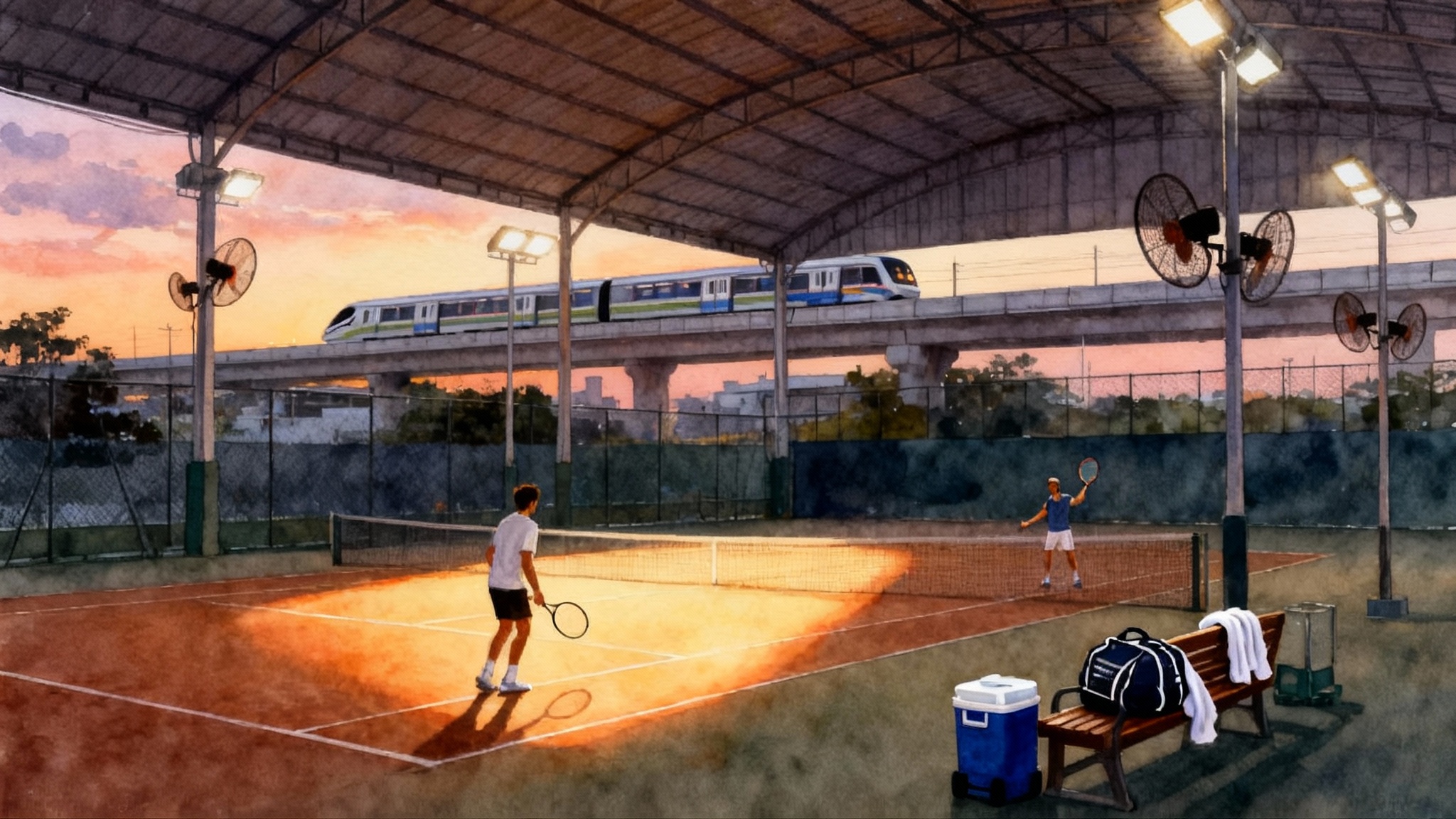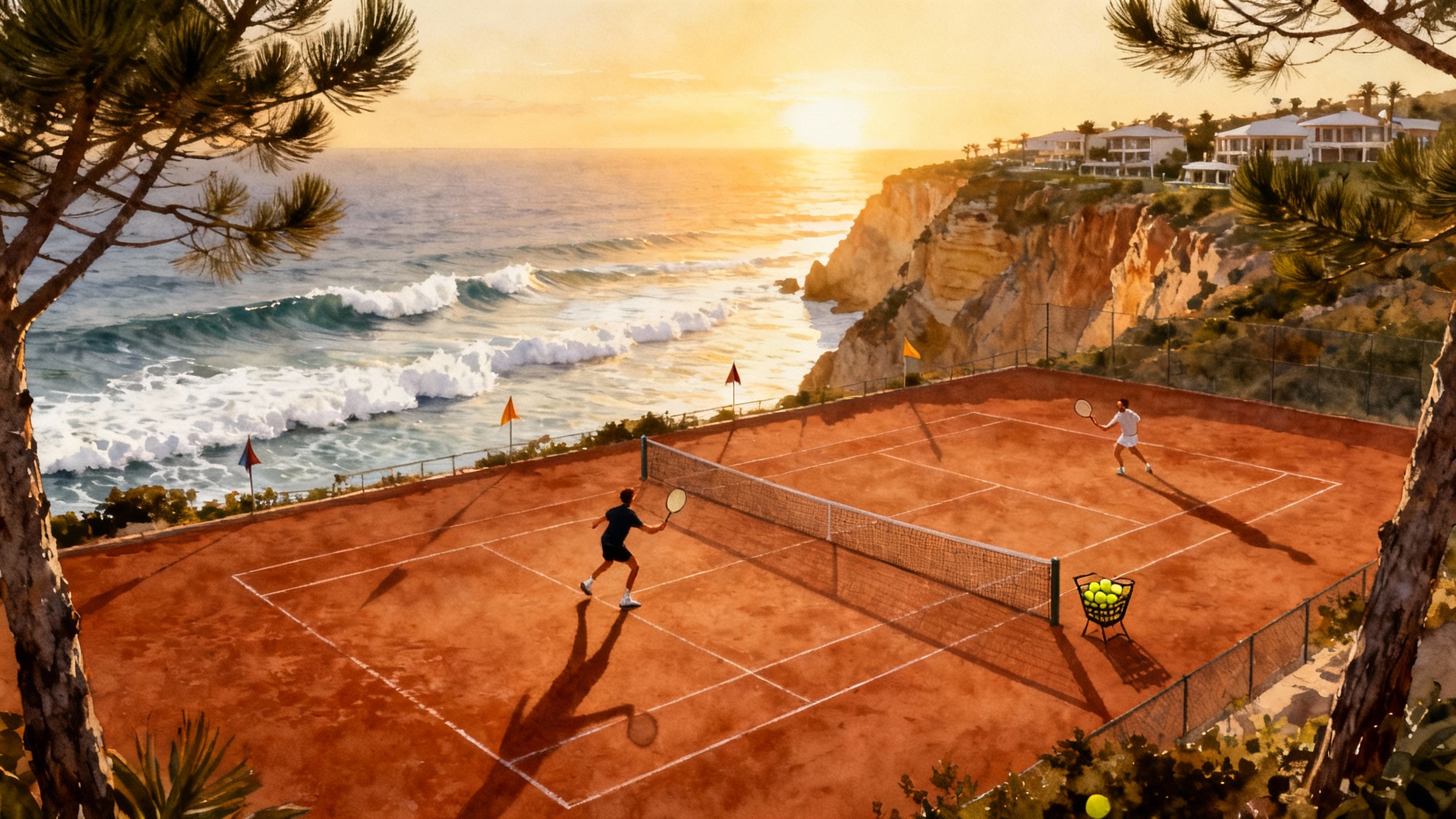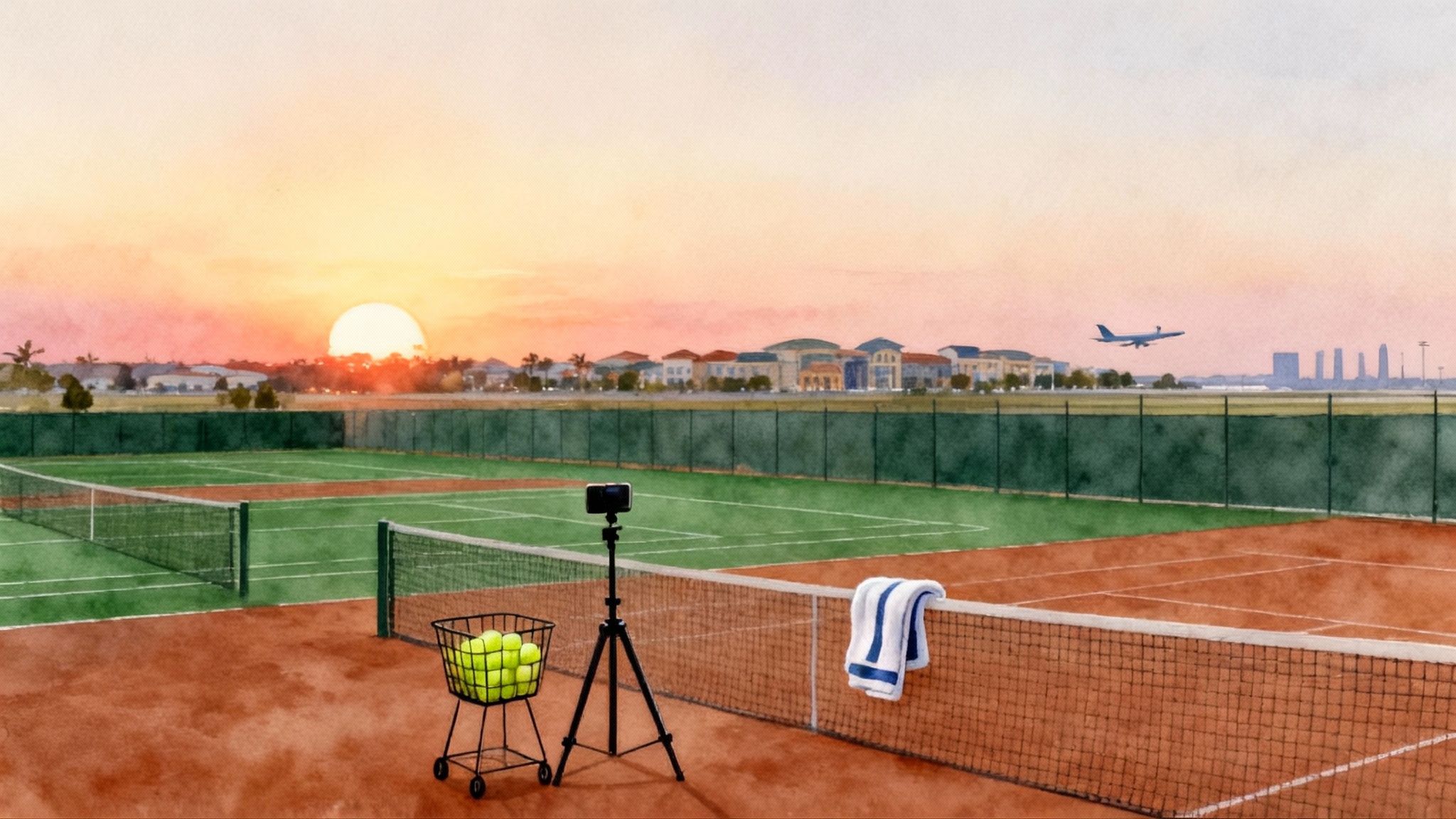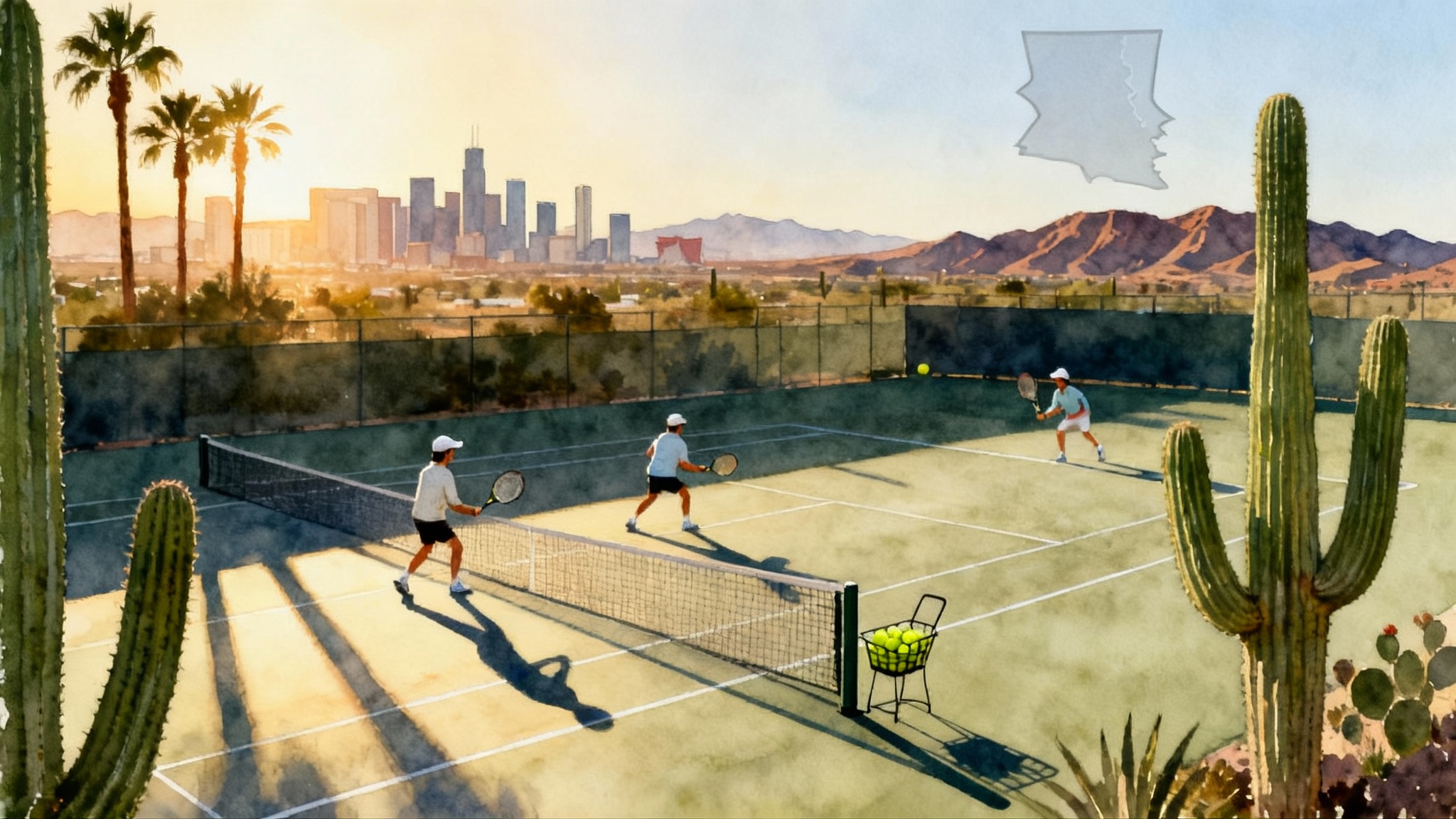Laguna Beach Tennis 2025-26: Ocean-Cooled Year-Round Guide
Why Laguna Beach is a better year-round bet than Florida or Spain
If you want hard-court rhythm without battling Florida’s sauna-like humidity or rebuilding movement patterns after weeks on Spain’s red clay, Laguna Beach is a smart base camp. The coastline here is cooled by a reliable marine layer that keeps temperatures mild, the sun filtered in the mornings, and the wind predictable most afternoons. That means fewer sessions lost to heat spikes, less ball fluff, more stable bounce, and a smoother week of progression. Your legs handle directional changes better on hard courts when the air is dry to moderate, and your strings maintain tension longer when nights are cool.
If you are weighing other destinations, compare with the South Florida clay corridor guide and this Valencia Tennis 2025–26 guide.
The microclimate playbook: months, wind, humidity, rain, and smoke
Laguna Beach benefits from the Pacific’s marine layer, a shallow blanket of cool, moist air that forms overnight and often lingers through late morning. This layer moderates temperatures and sun exposure, especially May through July, a pattern locals call May Gray and June Gloom. For training planning, treat the marine layer like a natural dome that keeps the first half of the day controlled and consistent. For background on how and why this layer forms, read the National Weather Service marine layer primer.
Here is how that translates into court decisions across the calendar:
- Optimal months for consistency: March through early July and mid September through early November. Expect cool mornings, gentle sun, and afternoon sea breezes that typically stay manageable. August and early September trend warmer, especially during offshore wind events. December through February are fully playable, yet bring the likeliest rain days.
- Daily time blocks: In spring and fall, target 7:00–10:30 a.m. for technical blocks and 4:00–7:00 p.m. for point play. In summer, slide your main load earlier to 6:30–9:30 a.m. and return 5:00–7:30 p.m. Avoid 11:30 a.m.–2:30 p.m. on clear days when glare and radiant heat peak. In winter, use 10:30 a.m.–2:30 p.m. for warmth, then a 3:30–5:30 p.m. lighter set play.
- Wind patterns: Light and variable in marine layer mornings, shifting to an onshore sea breeze many afternoons. Expect 6–12 miles per hour most days, stronger during dry Santa Ana periods. Plan serve and return work early, and use afternoon wind for depth-control drills and shape.
- Humidity: Morning relative humidity tends to feel moderate and comfortable. Once the sun breaks, it drops into a dry-to-moderate zone that is friendly for hard-court footwork. Offshore Santa Ana days bring very dry air and faster courts; reduce string tension a touch if you like more pocketing.
- Rain contingencies: Most precipitation lands in the December–March window. Courts drain quickly, but you need a plan for 1–3 rain days in a wet week. Keep an indoor strength session, a video breakdown block, and a short mobility-circuit template ready.
- Smoke and air quality: Fall can bring dry offshore winds and, occasionally, smoke from regional fires. Build an Air Quality Index rule set. Under 100 is normal training. Between 100 and 150, trim duration and monitor athletes with asthma. Over 150, shift indoors to mobility and video. Use official sources such as AirNow and your county air district for same-day checks.
Season-by-season time windows you can trust
You will not always know the forecast when booking months out, but you can book your training windows by season with confidence.
- Winter, December–February: Mornings start cool. Work technical changes and serve mechanics 10:30 a.m.–12:30 p.m. when the sun has warmed the surface. Add 90 minutes of point patterns 2:30–4:00 p.m. If a front is passing through, swap court time with a gym block and a high-speed video analysis session.
- Spring, March–May: The sweet spot. Plan two-a-days with 7:00–10:00 a.m. skill work and 4:00–6:30 p.m. live points. Expect marine layer mornings and mild afternoons. This is where you stack volume without overheating.
- Summer, June–August: Lean into early starts. 6:30–9:30 a.m. is gold for heavy drilling. Return at 5:00–7:30 p.m. for sets. On the few hot, clear days, reduce work–rest ratios at midday and protect skin with sleeves and a hat. Offshore wind days create quick, lively courts; if rallies shorten, shift focus to first-strike patterns.
- Fall, September–November: Another excellent window. September can spike warm for a week or two, but late September through November brings crisp mornings and clear light. Emphasize serve-plus-one and return-plus-one patterns in the afternoon breeze.
Rain playbook for December–March
A wet morning is not a lost day. Build an automatic contingency you can trigger the night before when rain probability crosses a threshold.
- Plan B template: 45-minute mobility and posterior-chain strength, 60-minute video review with annotated clips, 30-minute serve shadow work with resistance bands, then 20-minute breathwork for recovery.
- If courts are drying: Squeegee and towel the lines first. Start with mini-tennis in the service boxes, then expand to half court to limit slips. Avoid aggressive changes of direction until the baseline areas are visibly dry.
- Footwear: Pack a second pair of hard-court shoes so you can rotate dry pairs between sessions. Bring a microfiber towel for grips and a spare overgrip set in a zip bag.
Air quality and smoke protocols that protect training quality
Your lungs are your aerobic engine. When smoke enters the forecast during Santa Ana patterns, do not guess. Check an official index before breakfast and again after lunch. Under 100, proceed. Between 100 and 150, cut session time by 25 percent, extend rest intervals, and keep heart rates in an aerobic zone. Above 150, move indoors to mobility, strength, and video. If someone reports throat irritation or headache, stop courtside and re-check conditions. Treat AQI the way pilots treat visibility limits.
Your 7-day small-group intensive anchored at Laguna Beach Tennis Academy
Base your week at the Laguna Beach Tennis Academy profile, where small-group sessions keep coach-to-player ratios tight and let you layer progressions across the week.
- Day 1, Arrival and Baselines: Land midday at John Wayne Airport in Santa Ana for an easy transfer. Afternoon court check, footwork screen, and 60-minute feel session. Evening tide-pool walk at Heisler Park to decompress from travel and reset your eyes in ocean light.
- Day 2, Contact Height and Court Speed: Morning block 7:00–10:00 a.m. on contact point calibration, shoulder line stability, and cross-court depth. Afternoon 4:30–6:00 p.m. serve targets and second-serve shape. Recovery on the 1000 Steps Beach stairs with controlled descents and glute-focused ascents.
- Day 3, First-Strike Patterns: Morning 7:00–9:30 a.m. serve-plus-one and return-plus-one, with pattern calls from the coach. Afternoon split 5:00–6:30 p.m. short sets first to six. Optional sunset yoga in the village to open hips and calm the nervous system.
- Day 4, Defensive Neutral to Offense: Morning 7:00–9:30 a.m. depth defense, neutral ball, and transition forward. Afternoon 4:30–6:00 p.m. doubles-specific returns and volley hand speed. Active recovery with a tide-pool stroll at Shaw’s Cove. Use reef-safe sunscreen and check the tide.
- Day 5, Weapons Day: Morning 7:00–9:30 a.m. forehand acceleration and backhand drive through contact. Afternoon 4:30–6:30 p.m. pressure sets and tie-break ladders. Optional beginner-friendly surf at Thalia Street with a local lesson. If you surf, keep the tennis shoulder safe with short sessions.
- Day 6, Match Play and Scenario Training: Morning 7:00–9:30 a.m. set play with scouting goals. Track first-serve percentage, depth to a two-by-two zone, and return height. Afternoon 4:30–6:00 p.m. scenario games at 30–all and no-ad rehearsals. Sunset walk from Main Beach to the boardwalk.
- Day 7, Consolidation: Late start 8:00–10:00 a.m. technical touch-up and video bookends to compare Day 1 and Day 7. Afternoon off or light hit. Debrief with next-block assignments and a stringing plan for the coming month.
Group size: Three or four players with one coach keeps feed-to-feedback tight and live-ball reps high. If you bring a second coach, run a station for returns and a station for approach plus volley to double quality contacts.
Orange County tournament options while you are in town
If you want a competitive anchor during your training week, Orange County offers weekly USTA Southern California adult and junior events and frequent Universal Tennis Rating match play. Venues such as Great Park Tennis Center in Irvine, Costa Mesa Tennis Center, and clubs in Newport Beach host a steady calendar. The details shift across the year, so verify dates and levels on the USTA Southern California tournament calendar and filter for Orange County.
For college prospects, late winter and spring weekends often include Universal Tennis Rating events with open draws. For adults, look for Level 5 to Level 7 tournaments to keep volume high without wrecking recovery. If you are peaking for a higher-level event, taper volume on Days 5 and 6 and sharpen the serve.
Getting there and staying car-free
- Airports: John Wayne Airport in Santa Ana is the closest and simplest. Typical transfer to central Laguna Beach is about 25–35 minutes by ride-hail outside rush hours. Los Angeles International Airport is a larger hub with more flights; plan 70–120 minutes depending on time of day. If you prefer trains, ride Amtrak or Metrolink to Irvine or San Juan Capistrano, then a short rideshare to Laguna.
- Local transit: The Laguna Beach trolley runs frequent Coast Highway loops in peak seasons and reduced schedules in the off season. It is perfect for bouncing between hotel, courts, Main Beach, and restaurants. Orange County Transportation Authority buses serve Coast Highway year-round. Confirm seasonal schedules the week you travel.
Lodging near the courts: budget to premium
These picks prioritize walking distance to courts and food, plus easy trolley access.
- Budget friendly: Laguna Beach Lodge in South Laguna is a clean base with beach access across the highway. Seaside Laguna Inn is simple and close to sand and food. Capri Laguna on the Beach often prices in the midrange but has deals in shoulder months.
- Midrange favorites: Pacific Edge Hotel places you on a central stretch of beach and near casual food. Laguna Beach House is a short walk from Heisler Park and downtown. Hotel Laguna has reopened with revamped rooms and a prime coastline location.
- Premium stays: Montage Laguna Beach sits on a bluff with ocean paths and polished service. Surf and Sand Resort brings oceanfront rooms with balcony views and a straight shot to the sand. Hotel Joaquin offers a boutique feel and a quiet hilltop vibe.
If you arrive without a car, choose a place along Coast Highway between Main Beach and Woods Cove to keep walks short. Book ground-floor rooms if you plan to carry baskets and ball machines.
Fuel like an athlete: reliable food within walking distance
- Active Culture: Bowls, brown rice, and veggie-heavy plates. Add avocado and olive oil for calories on two-a-days.
- Urth Caffé Laguna Beach: Oatmeal, eggs, and clean sandwiches. Good pre-hit breakfast and a calm patio.
- Zinc Café: Plant-forward dishes, quinoa bowls, and strong coffee. Try the breakfast burrito on a heavy day.
- Banzai Bowls: Big acai bowls for a fast carb hit post-session. Add peanut butter and granola if you have a second hit later.
- Whole Foods Market: Stock up on hydration, fruit, and recovery snacks. If you need a quick dinner, grab rotisserie chicken and a salad kit.
- Laguna Coffee Company: Simple coffee and pastries. Pair a latte with a banana before an early start.
Hydration tip: Aim for 0.4 to 0.6 liters per hour on court in summer, plus 500–700 milligrams of sodium through a sports drink or electrolyte tabs. On marine-layer mornings, you can stay at the lower end of that range, then top up in the afternoon sea breeze.
Packing list for ocean-cooled hard courts
- Two pairs of hard-court shoes to rotate, which helps dry times and reduces blister risk.
- Lightweight long-sleeve for marine-layer mornings. Add a sun hoodie for noon transitions.
- Two string setups: your normal tension and one 1–2 pounds looser for dry, fast Santa Ana days.
- Grips and rosin for dry afternoons. A small towel for morning moisture.
- A visor or cap with a dark undervisor to cut glare on clear days.
- Resistance bands and a jump rope for warm-ups on the boardwalk or beach.
- A compact massage ball and a travel roller for calves and hips after the stairs.
How to structure your week based on the forecast
- Marine-layer week: Stack heavy technical work early, then play sets after 4:30 p.m. when wind adds a tactical element. You will get rep quality in the morning and resilience in the late session.
- Bluebird high-pressure week: Move skill blocks to the edges of the day to avoid glare and radiant heat. Insert a midday nap or beach walk. Keep afternoon sessions shorter but higher intensity.
- Rain week: Front-load video and strength on the wettest day. Extend days on either side with split sessions once courts are dry. Use indoor mobility to maintain tissue quality.
- Smoke-impacted week: Replace one afternoon set session with a low-impact swim or yoga. Use an indoor bike to keep the aerobic base without lung irritation.
Booking and timing strategies
- Fly into John Wayne for the least friction. Arrive by noon on Day 1 so you can move and sleep well.
- Choose shoulder seasons in late March–May and late September–November for the highest probability of perfect training windows.
- Build a 10 percent time buffer. If you plan six on-court sessions, schedule seven windows. The microclimate is friendly, but buffers keep stress low.
- If you want a tournament during your stay, lock your draw two to three weeks before arrival. If you remain flexible, you can often find a singles or doubles entry at a local venue within a short drive.
The bottom line
Laguna Beach gives you the best parts of coastal tennis without the tradeoffs that can derail a week. You get morning control from the marine layer, afternoon breeze for tactical practice, and a lifestyle setting that keeps recovery stress low. Compared with Florida, you avoid heavy humidity and heat lightning delays. Compared with Spain, you stay on hard courts so there is no footwork transition back to your home surface. Plan your windows, load your week with small-group intensives, and let the ocean-cooled air do its quiet work while you stack quality reps. Your game will feel sharper by the weekend, and you will leave with a repeatable plan you can run every season.
